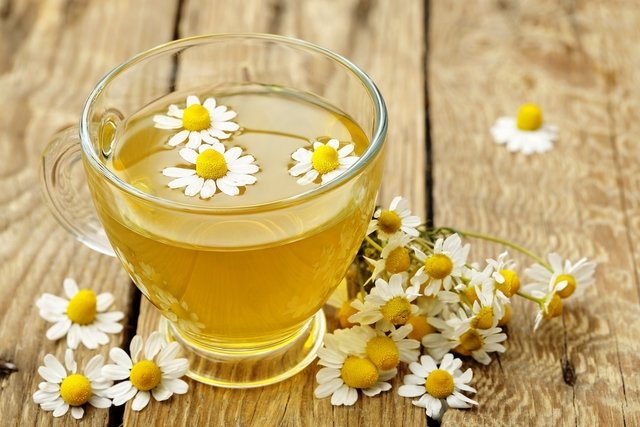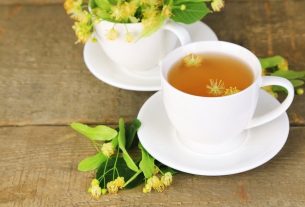Chamomile is a medicinal plant with white petals and a yellow center, which is widely used in the preparation of infusions to treat anxiety, insomnia, poor digestion and menstrual cramps. In addition, it also has excellent healing properties and can be used to help wounds heal.
The scientific name of chamomile is Matricaria recutita and the most used part is its flower, which is used to prepare infusions, inhalations, sitz baths, compresses or ointments. Furthermore, chamomile can also be used to season savory dishes such as pasta and chicken, or to flavor sweets such as brigadeiro and cakes.
Chamomile can be found in herbalists, health food stores, compounding pharmacies, markets and some open-air markets, in the form of dried flowers or tea bags.

Benefits of Chamomile
Chamomile has several health benefits and is therefore normally recommended for:
- Anxiety, nervousness or stress;
- Insomnia or difficulty sleeping;
- Indigestion;
- Gastritis or gastric ulcer;
- Diarrhea;
- Excess intestinal gas;
- Intestinal or menstrual cramps;
- Rheumatic pain;
- Drop;
- Headache;
- Hemorrhoids;
- Wounds, ulcers, burns or skin irritation;
- Colds or sinusitis.
Additionally, chamomile can also be used to help heal wounds or relieve inflammation in the gums, due to its healing and anti-inflammatory properties.
The benefits of chamomile are especially due to phenolic compounds, such as the flavonoids apigenin, luteolin, patuletin and quercetin, as well as essential oils, such as chamazulene and alpha-bisabolol, present in its composition.
How to use chamomile
Chamomile can be used in the form of tea, inhalations, sitz baths, compresses or ointments, prepared with the dried flowers of this plant.
1. Chamomile tea
Chamomile tea helps to relax, treat insomnia, anxiety and nervousness, in addition to relieving gastrointestinal problems, such as poor digestion, colic, diarrhea, gastritis or ulcers, for example.
Ingredients:
- 0.5 to 4 g of dried chamomile flowers;
- 1 cup (240 mL) boiling water.
Preparation mode:
Add the dried chamomile flowers to a cup of boiling water, cover, let it rest for about 5 to 10 minutes and strain before drinking.
This tea can be drunk 3 times a day, and if necessary, it can be sweetened with a teaspoon of honey.
Additionally, chamomile tea can be prepared with other ingredients such as fennel, peppermint or dried catnip to increase its calming and antispasmodic effect.
2. Inhalation with chamomile
Chamomile inhalation is an excellent home remedy for colds or sinusitis due to its calming properties. Furthermore, the steam from inhalation helps to warm and moisten the upper respiratory tract, relieving the symptoms of a blocked or runny nose, and can be done in adults or children.
However, inhalation in children must always be carried out under adult supervision, even if the child has previously inhaled, as there is a serious risk of burns.
Ingredients:
- 6 teaspoons of dried chamomile flowers;
- 1.5 to 2 liters of water.
Preparation mode:
Boil the water and add the chamomile flowers. Wait 5 to 10 minutes and then place your face over the bowl and cover your head with a towel to inhale the steam. It is important to breathe the steam as deeply as possible for up to 10 minutes, repeating 2 to 3 times a day.
3. Chamomile sitz bath
Chamomile has antibacterial action due to the substances present in its composition, such as flavonoids and alpha-bisabolol, and can be used as a sitz bath for candidiasis, as it helps to eliminate the Candida albicans and relieve symptoms of itching, swelling, irritation, pain or discomfort caused by candidiasis.
Furthermore, a sitz bath can be used to help treat hemorrhoids, due to the anti-inflammatory properties of chamomile.
Ingredients:
- 3 tablespoons of dry chamomile;
- 1 liter of water.
Preparation mode:
Boil water with chamomile. Strain the infusion, let it cool and take a sitz bath, placing the mixture in a basin or bathtub for 5 minutes, at least once a day.
4. Chamomile compresses
Chamomile can also be used in the form of compresses applied to the skin, to treat wounds, ulcers, burns or skin irritation, due to its anti-inflammatory and calming properties.
Ingredients:
- 20 to 30 g of fresh or dried chamomile flowers;
- 500 mL of boiling water.
Preparation mode:
Add fresh or dried chamomile flowers to boiling water and leave to rest for 15 minutes. Then strain, wet gauze, cotton or clean cloth and wipe the affected skin area at least twice a day.
5. Chamomile ointment
Chamomile ointment has anti-inflammatory and calming properties, and can be used for skin irritation or itching, prickly heat, diaper rash or sunburn, for example.
Ingredients:
- 5 g of beeswax;
- 45 mL of olive oil, coconut oil or sweet almond oil;
- 4 tablespoons of chopped dried chamomile flowers.
Preparation mode:
Place the beeswax and oil in a pan on a bain-marie until the mixture is completely liquid. Then, turn off the heat and add the dried chamomile flowers. Leave the ingredients in the pan for about 2 hours to release the active substances in the chamomile. Before cooling, strain and store the liquid part in a clean, dry glass container with a lid. Always keep the glass in a dry, dark and ventilated place. This ointment is valid for up to 1 year and can be applied to the skin 2 to 3 times a day.
Possible side effects
Side effects that may arise with the use of chamomile are nausea and skin irritation, especially when this plant is used in larger amounts than recommended.
Although rare, chamomile can also cause serious allergic reactions that require immediate medical attention. Therefore, you should stop treatment and seek the nearest emergency room if you experience symptoms such as difficulty breathing or wheezing, cold sweat, severe dizziness, a feeling of a closed throat, swelling in the mouth, tongue or face, or intense itching. Know how to identify the symptoms of a serious allergic reaction.
Who shouldn’t use
Chamomile should not be used by people allergic to chamomile or other plants in the same chamomile family, such as chrysanthemum, daisy, marigold or ragweed, for example.
Furthermore, chamomile should not be used by people who have changes in blood clotting or who are being treated with anticoagulants such as warfarin or heparin, as it may increase the risk of bleeding or hemorrhage. If surgery is necessary, the use of chamomile should be stopped two weeks before and after surgery.
Ingesting chamomile is not recommended for children under 6 months and inhaling this plant is not recommended for children under 6 years of age. Topical use of chamomile is only recommended for children over 12 years of age.
A simple chamomile (Matricaria recutita) can be used during pregnancy and breastfeeding, as long as it is indicated by your doctor. The use of Roman chamomile should be avoided, as there are still no studies that prove the safety of this type of chamomile during pregnancy and breastfeeding.

Sign up for our newsletter and stay up to date with exclusive news
that can transform your routine!
Warning: Undefined array key "title" in /home/storelat/public_html/wp-content/plugins/link-whisper-premium/templates/frontend/related-posts.php on line 12
Warning: Undefined array key "title_tag" in /home/storelat/public_html/wp-content/plugins/link-whisper-premium/templates/frontend/related-posts.php on line 13



